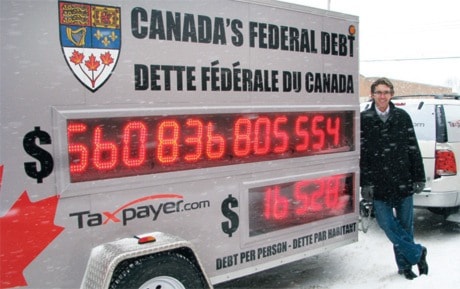By George Brown
In the week since the National Debt Clock rolled through Ponoka, Canada’s debt has increased almost $1 billion.
That financial fact was lost on Ponoka taxpayers who stayed warm indoors when the Canadian Taxpayers Federation (CTF) exhibit weaved its way through downtown streets March 2. The temperature was about -34 degrees C with the wind chill.
Scott Hennig, Alberta communications director, is taking the clock on one leg of its trans-Canada awareness tour. The clock, encased in a spruced up horse trailer, left Victoria, B.C. Feb. 22 and is expected to pull into Halifax, N.S. at the end of the month.
The tour plans to stop in Ottawa March 17.
“We’re trailering across Canada, trying to stop in as many communities as we can to show off the numbers and try to get the word out how big the debt is, what it looks like and try to get people to start turning it around,” Hennig said.
It’s been tough to communicate with Canadians across the Prairies this month because of the weather but Hennig said those who do come out to ask questions are glad to see someone is taking the message to government that the national debt has to be reduced.
It now stands at almost $562 billion.
Hennig said Canada’s debt increases $1,400 per second or $124 million per day. Each Canadian has a $16,500 share of the total debt.
The CTF is putting forward its Zero in Two budget plan to get Canada back to balanced budgets.
“They have a fairly sizeable deficit and we don’t think they can do it overnight but we figure they can do it in two years,” Hennig said.
The report presented to Finance Minister Joe Flaherty calls on the government to:
• Reduce program spending by $18 billion below 2010-11 levels in addition to curbing spending growth.
• Eliminate corporate welfare, regional development agencies and bio-fuel subsidies.
• Privatize Atomic Energy of Canada, Canada Post’s Purolator Courier and VIA Rail. Also, end taxpayer support for the CMHC and Canada Post.
• Reduce most departmental budgets by 10 to 25 per cent and freeze remaining budgets for two years.
• Reduce the Equalization Program by 10 per cent annually for two years and assist recipient provinces in paying down respective debts in lieu of cash-transfers.
• Pass a Taxpayer Protection Act to ban future deficits and tax increases without an explicit mandate to do so given in an election or referendum.
• Pass a Debt Retirement Act with a schedule for making Canada debt free.
Henning said those proposals would slow the amount of federal debt accumulation to about one-third in the first year and in the second year send the debt clock back into storage.
“We don’t blame this on one party,” Hennig said. “Not a single MP voted against the 2009 budget that started this in motion, that put out the stimulus package that really kicked things off,” Hennig said. “It came too late anyway and it really didn’t make any impact on the economy.
“This is a pox on all their houses.”
